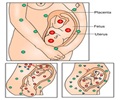Ever wonder why women don't fall flat on their faces during their pregnancy? Well, that’s because their spines are built in such a way.
In females the spines are built differently from men's. The finding was based on a study, led by Katherine Whitcome, a biological anthropologist at Harvard University in Cambridge, Massachusetts, US, which found that this difference allows a pregnant woman to lean backward to counterbalance the weight of her developing foetus.One problem with bipedalism, which is standing, or moving for example by walking, running, or hopping, on two appendages (typically legs though it can also include hand walking), is that the growing foetus sticks out to the front, shifting the mother's centre of mass forward of her hip joint, creating a tendency to tip over.
Pregnant quadrupeds, form of land animal locomotion using four legs, do not have this problem, because throughout pregnancy the mother's centre of mass remains between her front and hind limbs. "Were a pregnant chimpanzee to stand upright, she would experience a similar problem," Nature quoted Whitcome, as saying.
In the study published in Nature magazine, 19 women were reviewed as they progressed through pregnancy. The analysis found that the women corrected for their growing imbalance by bending backward in the lower part of their spine. Also, detailed anatomical measurements showed that the vertebrae of the lower back are more wedge-shaped in women than in men, which makes this bending easier.
Whitcome found that the interlocking bony projections that aligned each vertebra with its neighbours were also relatively larger in women, which provides added support to prevent the vertebrae from slipping sideways, as they otherwise might because of the sharper bend in the spine. Chimpanzees, which are mostly quadrupedal, do not show these vertebral adaptations.
However, when the researchers looked at the two known fossil spines of Australopithecus africanus, an ancestral human that lived 2 to 3 million years ago, they saw that one – believed to be a female – did have the wedge-shaped vertebrae and larger interlocking projections seen in modern women, while the other – believed to be a male – did not.
Advertisement
In another research, led by Lia Amaral from the University of Sao Paulo in Brazil, the carrying patterns in all nonhuman primates was studied and it was demonstrated a relationship between infant weight, hair friction and body angle which ensures that ape infants were carried safely.
Advertisement
Newborns are carried clinging to their mother’s stomach, often with additional support. Months later, infants are carried over the adult body usually on the mother’s back, and this carrying pattern lasts for years in apes. However, this necessity to carry infants safely imposes limits on the weight of the infants.
In the study, through a detailed mechanical analysis of how different types of apes - gibbons, orangutans and gorillas - carry their young, looking at the properties of ape hair, infant grip, adult hair density and carrying position, the researcher showed as to how the usual pattern of primate carrying of heavy infants is incompatible with bipedalism.
African apes have to persist with knuckle walking on all fours, or ‘quadruped’ position, in order to stop their young from slipping off their backs.
The researcher suggested that the fall in body hair in primates could have brought on bipedality as a necessary consequence, through the strong selective pressure of safe infant carrying, as infants were no longer able to cling to their mother’s body hairs. Amaral concluded that this evolution to bipedality has important consequences for the female of the species.
Indeed, it frees the arms and hands of males and juveniles, but females have their arms and hands occupied with their young. This restriction of movement placed limits on food gathering for biped females carrying their infants, and may have been at the origin of group cooperation.
This study is published online in Springer’s journal, Naturwissenschaften.
Source-ANI
LIN/P











